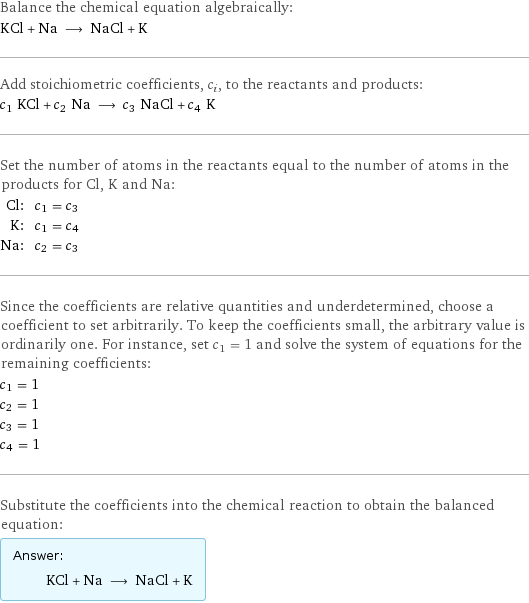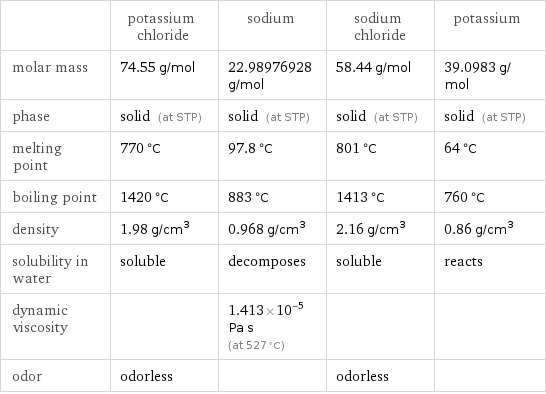Input interpretation

KCl potassium chloride + Na sodium ⟶ NaCl sodium chloride + K potassium
Balanced equation

Balance the chemical equation algebraically: KCl + Na ⟶ NaCl + K Add stoichiometric coefficients, c_i, to the reactants and products: c_1 KCl + c_2 Na ⟶ c_3 NaCl + c_4 K Set the number of atoms in the reactants equal to the number of atoms in the products for Cl, K and Na: Cl: | c_1 = c_3 K: | c_1 = c_4 Na: | c_2 = c_3 Since the coefficients are relative quantities and underdetermined, choose a coefficient to set arbitrarily. To keep the coefficients small, the arbitrary value is ordinarily one. For instance, set c_1 = 1 and solve the system of equations for the remaining coefficients: c_1 = 1 c_2 = 1 c_3 = 1 c_4 = 1 Substitute the coefficients into the chemical reaction to obtain the balanced equation: Answer: | | KCl + Na ⟶ NaCl + K
Structures

+ ⟶ +
Names

potassium chloride + sodium ⟶ sodium chloride + potassium
Reaction thermodynamics
Entropy

| potassium chloride | sodium | sodium chloride | potassium molecular entropy | 83 J/(mol K) | 51 J/(mol K) | 72 J/(mol K) | 64 J/(mol K) total entropy | 83 J/(mol K) | 51 J/(mol K) | 72 J/(mol K) | 64 J/(mol K) | S_initial = 134 J/(mol K) | | S_final = 136 J/(mol K) | ΔS_rxn^0 | 136 J/(mol K) - 134 J/(mol K) = 2 J/(mol K) (endoentropic) | | |
Equilibrium constant
![Construct the equilibrium constant, K, expression for: KCl + Na ⟶ NaCl + K Plan: • Balance the chemical equation. • Determine the stoichiometric numbers. • Assemble the activity expression for each chemical species. • Use the activity expressions to build the equilibrium constant expression. Write the balanced chemical equation: KCl + Na ⟶ NaCl + K Assign stoichiometric numbers, ν_i, using the stoichiometric coefficients, c_i, from the balanced chemical equation in the following manner: ν_i = -c_i for reactants and ν_i = c_i for products: chemical species | c_i | ν_i KCl | 1 | -1 Na | 1 | -1 NaCl | 1 | 1 K | 1 | 1 Assemble the activity expressions accounting for the state of matter and ν_i: chemical species | c_i | ν_i | activity expression KCl | 1 | -1 | ([KCl])^(-1) Na | 1 | -1 | ([Na])^(-1) NaCl | 1 | 1 | [NaCl] K | 1 | 1 | [K] The equilibrium constant symbol in the concentration basis is: K_c Mulitply the activity expressions to arrive at the K_c expression: Answer: | | K_c = ([KCl])^(-1) ([Na])^(-1) [NaCl] [K] = ([NaCl] [K])/([KCl] [Na])](../image_source/df7460d90ee17b40e7a09faa51639404.png)
Construct the equilibrium constant, K, expression for: KCl + Na ⟶ NaCl + K Plan: • Balance the chemical equation. • Determine the stoichiometric numbers. • Assemble the activity expression for each chemical species. • Use the activity expressions to build the equilibrium constant expression. Write the balanced chemical equation: KCl + Na ⟶ NaCl + K Assign stoichiometric numbers, ν_i, using the stoichiometric coefficients, c_i, from the balanced chemical equation in the following manner: ν_i = -c_i for reactants and ν_i = c_i for products: chemical species | c_i | ν_i KCl | 1 | -1 Na | 1 | -1 NaCl | 1 | 1 K | 1 | 1 Assemble the activity expressions accounting for the state of matter and ν_i: chemical species | c_i | ν_i | activity expression KCl | 1 | -1 | ([KCl])^(-1) Na | 1 | -1 | ([Na])^(-1) NaCl | 1 | 1 | [NaCl] K | 1 | 1 | [K] The equilibrium constant symbol in the concentration basis is: K_c Mulitply the activity expressions to arrive at the K_c expression: Answer: | | K_c = ([KCl])^(-1) ([Na])^(-1) [NaCl] [K] = ([NaCl] [K])/([KCl] [Na])
Rate of reaction
![Construct the rate of reaction expression for: KCl + Na ⟶ NaCl + K Plan: • Balance the chemical equation. • Determine the stoichiometric numbers. • Assemble the rate term for each chemical species. • Write the rate of reaction expression. Write the balanced chemical equation: KCl + Na ⟶ NaCl + K Assign stoichiometric numbers, ν_i, using the stoichiometric coefficients, c_i, from the balanced chemical equation in the following manner: ν_i = -c_i for reactants and ν_i = c_i for products: chemical species | c_i | ν_i KCl | 1 | -1 Na | 1 | -1 NaCl | 1 | 1 K | 1 | 1 The rate term for each chemical species, B_i, is 1/ν_i(Δ[B_i])/(Δt) where [B_i] is the amount concentration and t is time: chemical species | c_i | ν_i | rate term KCl | 1 | -1 | -(Δ[KCl])/(Δt) Na | 1 | -1 | -(Δ[Na])/(Δt) NaCl | 1 | 1 | (Δ[NaCl])/(Δt) K | 1 | 1 | (Δ[K])/(Δt) (for infinitesimal rate of change, replace Δ with d) Set the rate terms equal to each other to arrive at the rate expression: Answer: | | rate = -(Δ[KCl])/(Δt) = -(Δ[Na])/(Δt) = (Δ[NaCl])/(Δt) = (Δ[K])/(Δt) (assuming constant volume and no accumulation of intermediates or side products)](../image_source/82869d3a029b00299fc7310377e4a711.png)
Construct the rate of reaction expression for: KCl + Na ⟶ NaCl + K Plan: • Balance the chemical equation. • Determine the stoichiometric numbers. • Assemble the rate term for each chemical species. • Write the rate of reaction expression. Write the balanced chemical equation: KCl + Na ⟶ NaCl + K Assign stoichiometric numbers, ν_i, using the stoichiometric coefficients, c_i, from the balanced chemical equation in the following manner: ν_i = -c_i for reactants and ν_i = c_i for products: chemical species | c_i | ν_i KCl | 1 | -1 Na | 1 | -1 NaCl | 1 | 1 K | 1 | 1 The rate term for each chemical species, B_i, is 1/ν_i(Δ[B_i])/(Δt) where [B_i] is the amount concentration and t is time: chemical species | c_i | ν_i | rate term KCl | 1 | -1 | -(Δ[KCl])/(Δt) Na | 1 | -1 | -(Δ[Na])/(Δt) NaCl | 1 | 1 | (Δ[NaCl])/(Δt) K | 1 | 1 | (Δ[K])/(Δt) (for infinitesimal rate of change, replace Δ with d) Set the rate terms equal to each other to arrive at the rate expression: Answer: | | rate = -(Δ[KCl])/(Δt) = -(Δ[Na])/(Δt) = (Δ[NaCl])/(Δt) = (Δ[K])/(Δt) (assuming constant volume and no accumulation of intermediates or side products)
Chemical names and formulas

| potassium chloride | sodium | sodium chloride | potassium formula | KCl | Na | NaCl | K Hill formula | ClK | Na | ClNa | K name | potassium chloride | sodium | sodium chloride | potassium
Substance properties

| potassium chloride | sodium | sodium chloride | potassium molar mass | 74.55 g/mol | 22.98976928 g/mol | 58.44 g/mol | 39.0983 g/mol phase | solid (at STP) | solid (at STP) | solid (at STP) | solid (at STP) melting point | 770 °C | 97.8 °C | 801 °C | 64 °C boiling point | 1420 °C | 883 °C | 1413 °C | 760 °C density | 1.98 g/cm^3 | 0.968 g/cm^3 | 2.16 g/cm^3 | 0.86 g/cm^3 solubility in water | soluble | decomposes | soluble | reacts dynamic viscosity | | 1.413×10^-5 Pa s (at 527 °C) | | odor | odorless | | odorless |
Units
